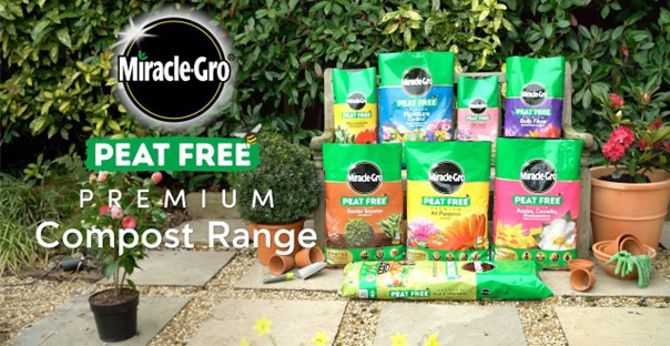This article first appeared in Horticulture Week, a British horticultural periodical, covering nursery production, garden retail, landscaping, arboriculture, garden heritage, groundsmanship and amenity horticulture.
Gardening saw robust growth since 2020, as increased time at home and a greater awareness of how gardening helps mental and physical wellbeing prompted households to take up more nature-orientated hobbies. Developed markets continue to spend more on their gardens in the hybrid work era, but the fastest growth came from emerging markets.
Beyond price increases, real demand for compost increased 13% over pre-pandemic levels, nearly double the growth rate for the wider gardening sector
Source: Euromonitor International
Studying the performance of activities and products linked to compost versus grass care helps reveal a lot about recent changes in gardening spend and space priorities.
Households sacrifice more lawn space in favour of other needs
A slow change like we saw with lawn mower demand up to 2019 reflects a purchase pattern of extended product lifespans from reduced use, and a small portion of households no longer replacing at end of life (an indicator of lawns being removed).
Lawn mowers as a portion of gardening spend gradually contracted from 8% in 2008 to 7% in the decade to 2019, and then dropped abruptly by the same increment to 6% in the three years to 2022. This is a useful proxy for tracking the decline of lawn space as other garden priorities rise, and the pattern of change in North America is the starkest.
The space taken is visibly reflected in the 5% growth spike in 2020 in outdoor furniture and storage, with lawns sacrificed for paving, decking or storage shed space. That was a one-off event, although the space use impact is clearly lingering…but this is only part of a longer-term pattern of change.
Grow-your-own food is the most obvious and lingering priority shift
The rising appeal of grow-your-own food is a fundamental change in gardening attitudes that resonated in the pandemic, attracting new gardeners to the sector – and it isn’t slowing down, with growth lasting well into the hybrid working period.
Grow-your-own is a consistent trend that boosted garden demand across the world, up 11% in real terms in 2022 versus pre-pandemic 2019
Source: Euromonitor International
This food trend is about declining faith in supermarkets, the appeal of “fresh” within the healthy eating trend, and offsetting inflation, with the food price index recently peaking at 63% above 2019.
Looking at growth rates across the largest gardening regions by spend, the main indicator of where that lawn space has been going is compost sales, linked to the two drivers: grow-your-own (a global trend) and decorative plants (stronger in emerging markets). Both drivers motivate adding more beds (especially raised beds) and planters, taking space away from lawns, and the greatest need for compost comes when repurposing ground, not just rotating crops within existing growing spaces.
Compost competition gets caught up in regulation and post-Brexit complexity
Organic plays a rising role in compost sustainability claims, and water waste (particularly water use in production from water-scarce countries) has been gaining ground due to extreme weather raising climate awareness. It is “peat-free” claims, however, that force the biggest changes, only partially driven by consumer intent.
Creating a peat-free compost market is forming part of policy for chasing CO2 emissions promises, and regulation is starting…but not everywhere. The UK Government is taking this issue more seriously than most, with a controversial peat ban coming into effect for retail compost in 2024, with nurseries and plant growers needing to follow suit, growing all plants in peat-free soil by the full ban which arrives in 2030 (delayed from 2028 after consultations).
Other governments aren’t in the same hurry. The Netherlands, for example, has no plans to end the use of peat, although it does have a reduction programme that extends some retail peat use beyond 2050. That decision is in sync with the rest of Europe, and beyond that region, this is more of a consumer and brand ethics topic rather than a regulatory one.
UK-based compost leaders Evergreen Garden Care Ltd and Westland Horticulture Ltd have a 61% share of the UK market between them, and they account for 25% of global compost sales
Source: Euromonitor International
This is a global topic because two of the top three manufacturers of compost originate from the UK, and the UK is home to peat-free specialists such as Southern Trident Ltd. These companies naturally have strong peat-free positions, they are spending on peat-free innovation in bark, coir and other natural fibres, and they push and promote peat-free claims internationally.

UK policies will drive peat-free investment, scale, and quality levels, making this choice easier for other markets to follow later. UK producers question, though, if domestic plants from 2030 will be on a level playing field with imports grown in peat, worrying also if peat-free exports will fare well versus local competition not so constrained. This is obviously a morally good choice; what is less obvious is if this will be fair. Given expressed fears about Brexit, there is a dark irony from the UK enacting a stricter regulation on gardening sustainability than its European neighbours.
On the wider level, gardening growth had an accelerated trajectory during the pandemic – we see a marked demand boom in both Asia Pacific and Latin America that are making both regions more attractive for investment and as export destinations, and we can see via analysis of how clients have been using Euromonitor International country and forecast data that interest levels in those regions is steadily rising.
For further analysis on home improvement and gardening industry trends, please read our report, World Market for Home Improvement and Gardening.

